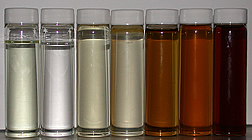
It seems biodiesel manufacturing process is responsible for the creation of a large quantity of crude glycerin. Only in U.S. about 340,000 tons of unrefined glycerin went to market, and the thing is we don’t see yet a solution to use it. So right now most of it is simply incinerated. Well that doesn’t make biodiesel a clean alternative energy anymore, does it? Now, half of the world’s crude glycerin is made only by biodiesel production.
Glycerin in its pure form is used to manufacture soap, cosmetics, pharmaceuticals and many other products, but the crude glycerin is an impure form that is unsuitable for these products. But what if we could use it putting back biodiesel in its correct position of green alternative power source?
Pure glycerin is colorless, odorless, non toxic and it’s made of 3 carbon atoms, 8 hydrogen atoms and 3 oxygen atoms. Using steam and absorbent filters, Dr. Valerie Dupont from the University of Leeds UK, has separated the 3 atoms resulting a rich hydrogen gas. The hydrogen-rich molecule is separated through the process called Unmixed and Sorption-Enhanced Steam Reforming and could be used in the alternative energy field for large power generating systems but as well for portable fuel cells.
But researchers do not stop here. Truman State University are investigating a way to use glycerin as a base food for cattle and as well to develop a nontoxic antifreeze liquid (propylene glycol). Crude glycerin is used at Virginia Tech to grow microalgae that produce omega 3 fat acids, an important nutrient. Besides this the algae can be used as animal food afterwards. Other researchers are focused to produce ethanol and methanol, including a new low-impact methanol production process that yields methanol without releasing hydrocarbon gasses as a byproduct.
Looking at current developments, crude glycerin could be the next gold mine of the future. It just depends un us if we learn to use it well or keep burning it.

